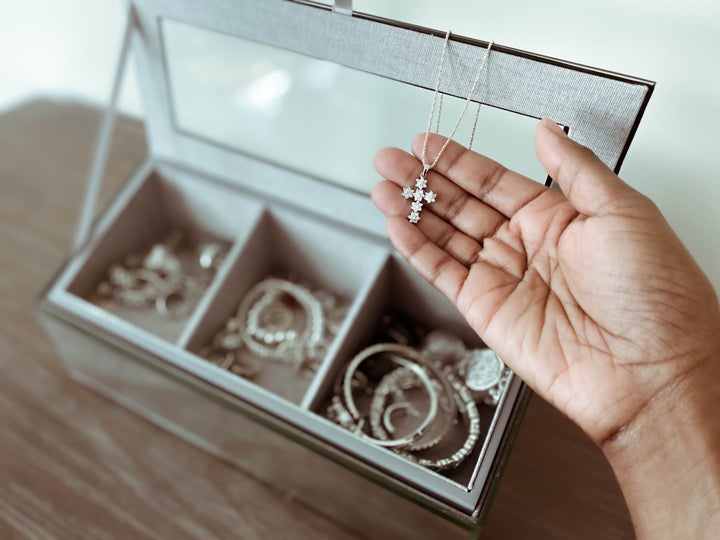
If you’ve ever bought or received a piece of jewellery that came with a warning to store it separately from other necklaces, bracelets and earrings but thought, “What’s the worst that could happen?” — the answer is: scratching and oxidation.
“The issue is if you put two metals together, you create, basically, a battery; a galvanic cell where these ions will transport across one another and that’ll lead to corrosion,” Marcus Young, a material sciences and engineering associate professor at the University of North Texas, told HuffPost.
A galvanic cell causes spontaneous oxidation-reduction reactions that result in pitting and discolouration of the jewellery, Young explained. “These [reactions] form on that surface and they make it no longer shiny, nice metal,” he said.
Copper-based pieces are most prone to these types of reactions, and silver is another one ― storing silver with other metals can cause it to oxidise faster.
How fast a piece oxidises depends on the alloy percentage, or how much of each metal makes up the final product. Judith Anderson, a professional jewellery appraiser, told HuffPost that platinum will not tarnish because it has no base metals in it, but different types of gold have different makeups.
“If you’re looking at 14-karat gold, it’s only 58.5% pure gold,” Anderson said. “The remaining components are usually a combination of silver and copper in varying ratios, depending on the colour. If you’re looking at white gold, it either has nickel in it as an alloy or could also have iridium in it, which is in the platinum group.”
Other gold variations, like rose gold, typically don’t consist of nickel but do have more copper than silver, while green gold has a higher amount of silver than it does copper.
The jewellery industry doesn’t use one standard ratio to create gold, though. “Different craftspeople have their own recipes when they’re alloying their gold,” Anderson said. “Large companies that sell gold have a specific formula they use for their production. What causes the colour is the variation of ratio between the copper and the silver content.”
Even sterling silver “is not pure,” Anderson said. “It still has alloys in it and so it will still tarnish.”
Scratching between dissimilar metals occurs because of their different hardness levels. For example, “platinum doesn’t oxidise, but it can get scratched because it’s actually a little bit softer than gold,” Anderson said. “So if you store platinum and gold jewellery together, the gold might scratch the platinum piece and you’d start to develop a duller finish.”
The Best Way To Store Jewellery
Exposure to the air contributes largely to oxidation, which is why experts agree that storing items individually in clean, dry environments remains the optimum method for keeping all jewellery scratch- and tarnish-free.
“That’s the No. 1 tip regardless of if it’s silver, gold or platinum,” said Amanda Gizzi of Jeweller’s of America. “Keeping them separate will keep them looking their best.”
For silver, Gizzi advised using tarnish-free storage boxes specifically designed for the metal. And she warned against piling pieces into a jewellery box where they end up sitting on top of one another and getting tangled. Instead, Gizzi suggested installing dividers in a large jewellery box or storing items in individual plastic baggies.
“That’s how almost all jewellers store everything,” Gizzi said of the latter option. For necklaces, Gizzi offered up the hack of leaving the clasp hanging out of the bag to keep it from getting tangled.
Anderson goes as far as storing each earring in an individual baggie and then putting the two baggies in one bigger bag to keep the pair together. “If you really take very good care of things, you don’t have to have it repaired and polished as often,” she said.
Young noted that a cloth-lined jewellery box will help keep additional moisture from damaging its contents. “The more humid something is, the more moisture in the air can promote that oxide hydroxide formation that would lead to tarnish,” he reiterated.
For anyone who wants to keep their items on display, Anderson likes to frame window screens and put individual earrings through each hole. “I wouldn’t do that with really expensive jewellery, because you don’t want them sitting out where someone could see them, but if you have inexpensive earrings, that’s a good way to store them,” she said, acknowledging that this method doesn’t prevent against oxidation but does work to keep items separate.
This approach can also be used for chains by adding hooks to a utility tray (display forms jewellers use for overstock and to store pieces overnight) and putting a frame around it.
What To Do If You Notice Scratching Or Tarnishing
Despite best intentions, normal wear and tear of our beloved jewellery happens. Anderson said that for silver, you can use a commercial silver cleaner, but for gold, you’ll want to head to the jeweller so they can polish it on a polishing or buffing wheel.
“The best thing to do is take those pieces to your local jeweller,” Gizzi agreed. “Either have it polished or at minimum, cleaned. That general maintenance should be happening around once a year anyway.”
But patina, the sheen on a jewellery’s surface due to age or polishing, can also be embraced.
“There’s some beauty in the corrosion process,” Young said. “Patina is natural. There’s a question of, if it was shiny, do you want to restore it or do you want to have some sort of natural beauty to the jewellery? Generally we want them to be shiny but you don’t want to excessively clean jewellery either, because you don’t want to remove the surface.”
See, too much cleaning can be a bad thing.